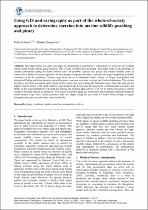 ResearchSpace
ResearchSpace
Using GIS and cartography as part of the whole-of-society approach to determine coercion into marine wildlife poaching and piracy
JavaScript is disabled for your browser. Some features of this site may not work without it.
- ResearchSpace
- →
- Research Publications/Outputs
- →
- Conference Publications
- →
- View Item
| dc.contributor.author |
Schmitz, P

|
|
| dc.contributor.author |
Gonçalves, D

|
|
| dc.date.accessioned | 2019-10-09T09:20:06Z | |
| dc.date.available | 2019-10-09T09:20:06Z | |
| dc.date.issued | 2019-07 | |
| dc.identifier.citation | Schmitz, P. & Gonçalves, D. 2019. Using GIS and cartography as part of the whole-of-society approach to determine coercion into marine wildlife poaching and piracy. In: 29th International Cartographic Conference (ICC 2019), 15–20 July 2019, Tokyo, Japan | en_US |
| dc.identifier.issn | 2570-2084 | |
| dc.identifier.uri | https://www.adv-cartogr-giscience-int-cartogr-assoc.net/1/18/2019/ | |
| dc.identifier.uri | https://doi.org/10.5194/ica-adv-1-18-2019 | |
| dc.identifier.uri | http://hdl.handle.net/10204/11158 | |
| dc.description | Presented at: : 29th International Cartographic Conference (ICC 2019), 15–20 July 2019, Tokyo, Japan. | en_US |
| dc.description.abstract | This paper builds on a previous paper on determining a community’s vulnerability to coercion into wildlife crimes along South African game reserves with a focus on rhinoceros poaching. This paper looks at the profiling of coastal communities along the South African coast for possible coercion into piracy and marine wildlife crime as context for a whole-of-society approach. As with the previous paper the criteria and data are based on publicly available resources to do the profiling. Criteria range from access to motorised boats, history of illegal, unregulated and unreported fishing activities, poverty, unemployment, closeness to marine reserves and levels of education. The criteria for piracy are based on articles and reports on the reasons for piracy along the Somalian coast. From the analysis the highest risk for piracy is the south-western Cape around Cape Town since the proximity to international sea routes, the ability of the local population to do deep-sea fishing and existing gang activity. The risk to marine resources is similar owing to the same reasons as for piracy. It is a known fact that gangs are involved in the poaching of abalone along the south-western Cape coast. Socio-economic risks are higher along the east coast of South Africa owing to higher unemployment, poverty and lower education levels. | en_US |
| dc.language.iso | en | en_US |
| dc.relation.ispartofseries | Workflow;22618 | |
| dc.subject | Wildlife crimes | en_US |
| dc.subject | Wildlife poaching | en_US |
| dc.subject | Marine resources | en_US |
| dc.subject | Rhinoceros poaching | en_US |
| dc.subject | Abalone poaching | en_US |
| dc.title | Using GIS and cartography as part of the whole-of-society approach to determine coercion into marine wildlife poaching and piracy | en_US |
| dc.type | Conference Presentation | en_US |
| dc.identifier.apacitation | Schmitz, P., & Gonçalves, D. (2019). Using GIS and cartography as part of the whole-of-society approach to determine coercion into marine wildlife poaching and piracy. http://hdl.handle.net/10204/11158 | en_ZA |
| dc.identifier.chicagocitation | Schmitz, P, and D Gonçalves. "Using GIS and cartography as part of the whole-of-society approach to determine coercion into marine wildlife poaching and piracy." (2019): http://hdl.handle.net/10204/11158 | en_ZA |
| dc.identifier.vancouvercitation | Schmitz P, Gonçalves D, Using GIS and cartography as part of the whole-of-society approach to determine coercion into marine wildlife poaching and piracy; 2019. http://hdl.handle.net/10204/11158 . | en_ZA |
| dc.identifier.ris | TY - Conference Presentation AU - Schmitz, P AU - Gonçalves, D AB - This paper builds on a previous paper on determining a community’s vulnerability to coercion into wildlife crimes along South African game reserves with a focus on rhinoceros poaching. This paper looks at the profiling of coastal communities along the South African coast for possible coercion into piracy and marine wildlife crime as context for a whole-of-society approach. As with the previous paper the criteria and data are based on publicly available resources to do the profiling. Criteria range from access to motorised boats, history of illegal, unregulated and unreported fishing activities, poverty, unemployment, closeness to marine reserves and levels of education. The criteria for piracy are based on articles and reports on the reasons for piracy along the Somalian coast. From the analysis the highest risk for piracy is the south-western Cape around Cape Town since the proximity to international sea routes, the ability of the local population to do deep-sea fishing and existing gang activity. The risk to marine resources is similar owing to the same reasons as for piracy. It is a known fact that gangs are involved in the poaching of abalone along the south-western Cape coast. Socio-economic risks are higher along the east coast of South Africa owing to higher unemployment, poverty and lower education levels. DA - 2019-07 DB - ResearchSpace DP - CSIR KW - Wildlife crimes KW - Wildlife poaching KW - Marine resources KW - Rhinoceros poaching KW - Abalone poaching LK - https://researchspace.csir.co.za PY - 2019 SM - 2570-2084 T1 - Using GIS and cartography as part of the whole-of-society approach to determine coercion into marine wildlife poaching and piracy TI - Using GIS and cartography as part of the whole-of-society approach to determine coercion into marine wildlife poaching and piracy UR - http://hdl.handle.net/10204/11158 ER - | en_ZA |





